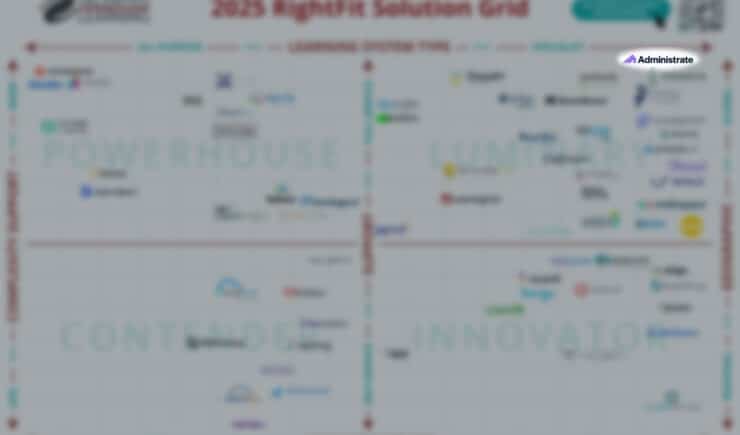When we analyze the effectiveness of our training initiatives we’re often reporting from various disconnected systems that only report on a one-to-one relationship between the data source and the activity itself. While activity metrics are captured, critical data analysis is often missing. This makes it difficult for our learning analytics to drive data-driven decision making. At the end of the process, we are stuck looking at raw data points instead of leveraging data analysis to drive organiziational change. For example:
- Your LMS reports may serve you data on completion rates, learner engagement, and training progression through a ‘Safety at Work’ course, but do these numbers demonstrate that your learners are making fewer safety errors?
- The LXP data shows you the content your leaders are engaging with, and helps you find what content to serve to your top performers, but does it tell you how learners are using this content to become more dynamic leaders?
- HRIS data show you which learners need to renew training and which certifications are out of date, but if this data isn’t correlated with your training data and your learner records, regulatory audits can be very frustrating.
Single-solution training software has limited our reporting mentalities; in order to make a shift to tackle challenges with data first, we need to reframe our mindset and strive for better, more adaptable training reports.
After all, data is the ultimate equalizer, and activity metrics rarely cover the whole story.
If all of your systems were integrated through a training management system, data captured in each system would be interrelated in one place. That would enable you to use the data to easily pinpoint challenges and then create training to overcome them.
A training management system helps training teams achieve a unified context for their training via a single system: software infrastructure that acts as the ‘glue’ for the rest of your critical learning tech.
A Story About Patrick Maroon – How the ‘Glue’ Impacts Change
In 2019, the Tampa Bay Lighting took a gamble and signed Patrick Maroon. They were eager to end a 16-year championship drought, and Maroon was their strategic move.
His appeal was not in his personal statistics, but in his reputation as a “glue guy”. The St. Louis Blues’ 2018 Stanley Cup win had been credited to Maroon’s on-ice leadership. When he was playing, the rest of the team improved, even if his own performance unimpressive.
It paid off for Tampa – they won the 2020 Stanley Cup. Having Maroon on the roster provided intangible leadership – ”glue” – that wasn’t reflected in the traditional statistics.
A training operations platform can play a similar role in helping your training team orchestrate organizational success. Your team leads organizational change by empowering learners to become dynamic leaders and providing your business with agility so that it can remain competitive at crucial moments.
Fulfilling that critical role requires that your team’s systems are ‘stuck’ together, coordinating effectively both to produce success and to demonstrate it to business leaders. A lack of cohesion in your systems can leave your data incomplete and under-utilized, making it difficult to prove training’s ROI and ensure you’re delivering value to the business.
How Your Team Can Draw Connections to Maximize the Potential of Training Data
If it were as simple as saying “this student took a course on building agile frameworks and now we know they’ll help their team implement and succeed at agility,” then activity metrics would cover the bases. But, as training professionals, we rarely have access to the data that shows the learner has taken that training and implemented it to effect change in their daily life, within their teams, and in the organization.
The story that needs to be told is that your learners took training on implementing agile frameworks within the support process, and, as a result, support ticket satisfaction has gone from 70% to 85%. This is a simple example, but it shows the correlation between training and the outcome, and provides an immediate demonstration of the ROI of your training.
What’s needed is a reporting structure capable of combining data from all sources so your training team can take your activity metrics and connect them to the targets your organization is trying to reach.
There is a ‘glue’ component here that is not often considered. Yet, that glue can never result in cohesion unless it is given the chance to connect to efforts that the rest of the organization can quantify in terms of measurability. However, asking for the data that creates cohesion is time-consuming for training teams and frustrating to other departments.
It wastes time and slows down the entire process – is there an alternative?
Making a Mindset Shift
How a Training Management System Creates a Comprehensive Environment for Training Teams
We live in the future of SaaS and interrelation between software, right now. Unfortunately, most of this is taking place around training teams instead of with training teams.
Customer service, finance, and sales teams have software that pushes and pulls important data from multiple sources into one platform. Meanwhile, L&D teams take data from their HRIS, LMS, and LXP–and many other systems–and try to create a decision-based connection that’s interrelated. Uniting these systems is typically an ineffective, spreadsheet-driven process that limits growth.
Your data’s quality becomes irrelevant when it is expressed through spreadsheets with no direction or connectivity to the rest of the organization. No pivot table is ever going to provide the level of insight and intelligence you need to prove that L&D is a valuable part of your business’s strategy.
This isn’t an issue of the value that L&D teams provide. It’s an issue of data connectivity.
Reporting infrastructure should comprise your data into a single system. It should also connect that data to wider organizational objectives. Both of these factors are necessary to create cohesion.
Leveraging New Technology: Headless Architecture & A.I. in Training Operations
Headless architecture is a software philosophy that separates backend operations work from a frontend user experience. Common in e-commerce, headless approaches to training software are just catching on, but this technology offers deep potential to capture data far beyond activity metrics or can capture activity metrics in new ways that offer better learner experiences. It works because it allows new integrations, applications, and solutions for training to be seamless built right into the core backend processes.
Some of our clients are deploying headless architecture to build unique learner experiences that track learning engagement anonymously and then complies everything into the correct learner record when the learner eventually logs back into their training portal. Beyond providing a better experience for the learner, who can now rapidly engage with micro learning, it also reveals new demographic, usage, and engagement data.
Moving beyond activity metrics will vastly increase the sheer volume of training data that needs to be processed and analyzed. A.I. is a powerful tool to help training managers understand all of this data, and when integrated with training scheduling software, turn training data into tangible action.
L&D Teams Haven’t Had Software Infrastructure, Until now.
There are software solutions out there that say they can handle the vast data your team captures, but too often this software pigeon-holes your data into pre-set reports, data fields, and outputs you don’t define.
This is partly because training software has historically been solely focused on the learner experience. But the best learner experiences are developed by training teams that have a comprehensive, data-driven understanding of their own operations and the needs of their organization. Ensuring that training teams have the management tools to keep up with the rest of the organization is key to ensuring a high quality of training for learners.
Part of that management-side improvement is the need to simplify and automate enterprise training operations, which increases the importance of an effective learning tech ecosystem.
[A Guide] High-Performing Training Teams Are Leading Change
Organizations depend on training management that’s well defined and integrated with organizational systems. Training professionals require technology that prioritizes data-empowerment, and offers no-code reporting that shows how training tackles organizational goals. Featured in this guide, two training executives discuss why training programs need Business Intelligence.


.png)



